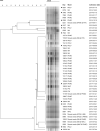Ward-specific clustering of methicillin-resistant Staphylococcus aureus spa-type t037 and t045 in two hospitals in South Africa: 2013 to 2017
- PMID: 34185791
- PMCID: PMC8241065
- DOI: 10.1371/journal.pone.0253883
Ward-specific clustering of methicillin-resistant Staphylococcus aureus spa-type t037 and t045 in two hospitals in South Africa: 2013 to 2017
Abstract
Introduction: Methicillin-resistant Staphylococcus aureus (MRSA) is a highly clonal pathogen causing infections in various settings. The aim of this study was to determine if healthcare-associated (HA) MRSA isolates with the same spa-type originating from two geographically distinct hospitals in South Africa were genetically related based on PFGE. Furthermore, a small subset of MRSA isolates were characterised with WGS and then compared to PFGE to determine if PFGE is still a reliable method to define outbreaks and/or transmission chains.
Methods: Staphylococcus aureus isolated from blood cultures (BC) were submitted to the Centre for Healthcare-Associated Infections, Antimicrobial Resistance and Mycoses (CHARM) as part of a laboratory-based surveillance programme (GERMS-SA). The identified HA-MRSA isolates underwent molecular characterisation [Staphylococcal Chromosome Cassette (SCC) mec and spa-typing]. Pulsed-field gel electrophoresis (PFGE) was performed on selected isolates with the same spa-type. Twenty-one MRSA isolates were selected for whole-genome sequencing (WGS) based on spa-type, PFGE clustering, time and place of isolation.
Results: Eighteen percent (n = 95/529) and 33% (n = 234/710) of isolates collected, from two public tertiary academic hospitals in the Gauteng (GAU) and the Western Cape (WC) provinces, were identified as MRSA, respectively. The most dominant clone in the GAU hospital was t037-III-MRSA (43.2%; n = 41/95). The most dominant clones in the WC hospital was t037-III-MRSA (23.9%, n = 56/234) and t045-I-MRSA (23.5%, n = 55/234). The GAU-t037-III-MRSA cases and WC-t045-I-MRSA cases occurred in the paediatric patient population, whereas the WC-t037-III-MRSA cases occurred in the adult patient population. A novel spa-type (t19935) was detected in the GAU hospital. PFGE showed that the GAU- and WC-t037-III-MRSA isolates were genetically indistinguishable, as well as most of the WC-t045-I-MRSA isolates. The Vienna/Hungarian/Brazilian clone and British EMRSA-3 clone were in circulation and a low frequency of single nucleotide polymorphisms (SNP) (≤20) differences was observed among isolates with the same spa-type.
Conclusion: The low number of SNP differences is suggestive of uninterrupted strain transmission and the persistence of t037-III-MRSA and t045-I-MRSA from 2013 to 2017 in the two studied hospitals. Alternative infection prevention and control strategies should be considered to supplement control efforts.
Conflict of interest statement
The authors have declared that no competing interests exist.
Figures



Similar articles
-
[Infectivity-resistotype-genotype clustering of methicillin-resistant Staphylococcus aureus strains in the Central Blacksea Region of Turkey].Mikrobiyol Bul. 2014 Jan;48(1):14-27. Mikrobiyol Bul. 2014. PMID: 24506712 Turkish.
-
Molecular evidence for spread of two major methicillin-resistant Staphylococcus aureus clones with a unique geographic distribution in Chinese hospitals.Antimicrob Agents Chemother. 2009 Feb;53(2):512-8. doi: 10.1128/AAC.00804-08. Epub 2008 Nov 24. Antimicrob Agents Chemother. 2009. PMID: 19029328 Free PMC article.
-
Concomitant genotyping revealed diverse spreading between methicillin-resistant Staphylococcus aureus and methicillin-susceptible Staphylococcus aureus in central Taiwan.J Microbiol Immunol Infect. 2016 Jun;49(3):363-70. doi: 10.1016/j.jmii.2014.07.010. Epub 2014 Oct 11. J Microbiol Immunol Infect. 2016. PMID: 25305708
-
Whole-genome sequencing analysis of molecular epidemiology and silent transmissions causing meticillin-resistant Staphylococcus aureus bloodstream infections in a university hospital.J Hosp Infect. 2023 Sep;139:141-149. doi: 10.1016/j.jhin.2023.05.014. Epub 2023 Jun 8. J Hosp Infect. 2023. PMID: 37301229 Review.
-
Dissemination Pattern of Hospital-Acquired Methicillin-Resistant Staphylococcus aureus and Community-Acquired MRSA Isolates from Malaysian Hospitals: A Review from a Molecular Perspective.Malays J Med Sci. 2023 Apr;30(2):26-41. doi: 10.21315/mjms2023.30.2.3. Epub 2023 Apr 18. Malays J Med Sci. 2023. PMID: 37102054 Free PMC article. Review.
Cited by
-
The Plasmidomic Landscape of Clinical Methicillin-Resistant Staphylococcus aureus Isolates from Malaysia.Antibiotics (Basel). 2023 Apr 9;12(4):733. doi: 10.3390/antibiotics12040733. Antibiotics (Basel). 2023. PMID: 37107095 Free PMC article.
-
Genomic Characterization of Methicillin-Resistant and Methicillin-Susceptible Staphylococcus aureus Implicated in Bloodstream Infections, KwaZulu-Natal, South Africa: A Pilot Study.Antibiotics (Basel). 2024 Aug 23;13(9):796. doi: 10.3390/antibiotics13090796. Antibiotics (Basel). 2024. PMID: 39334971 Free PMC article.
-
Dissemination of carbapenemase-producing Enterobacterales in the community of Rawalpindi, Pakistan.PLoS One. 2022 Jul 8;17(7):e0270707. doi: 10.1371/journal.pone.0270707. eCollection 2022. PLoS One. 2022. PMID: 35802735 Free PMC article.
-
Antimicrobial resistance and genomic analysis of staphylococci isolated from livestock and farm attendants in Northern Ghana.BMC Microbiol. 2022 Jul 21;22(1):180. doi: 10.1186/s12866-022-02589-9. BMC Microbiol. 2022. PMID: 35864456 Free PMC article.
References
-
- Jevons MP. “Celbenin”—resistant Staphylococci. Br Med J. 1961;1:124–125. https://doi.org/PMC1952888.
MeSH terms
LinkOut - more resources
Full Text Sources
Medical
Molecular Biology Databases
Research Materials

